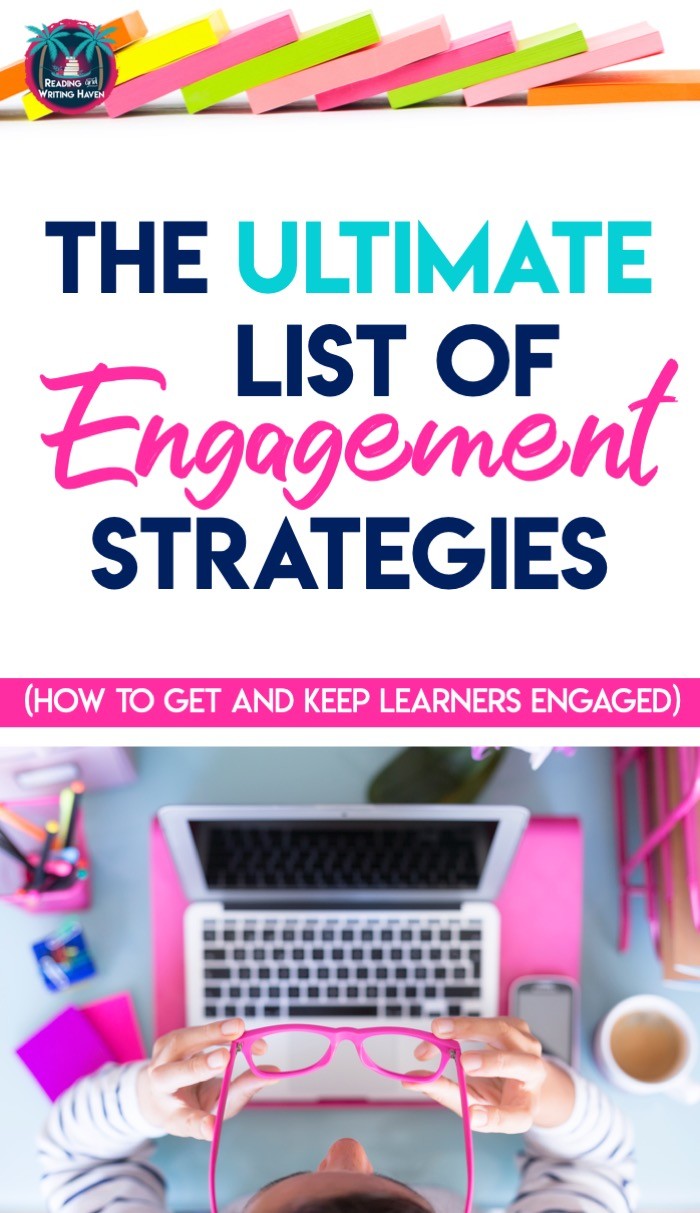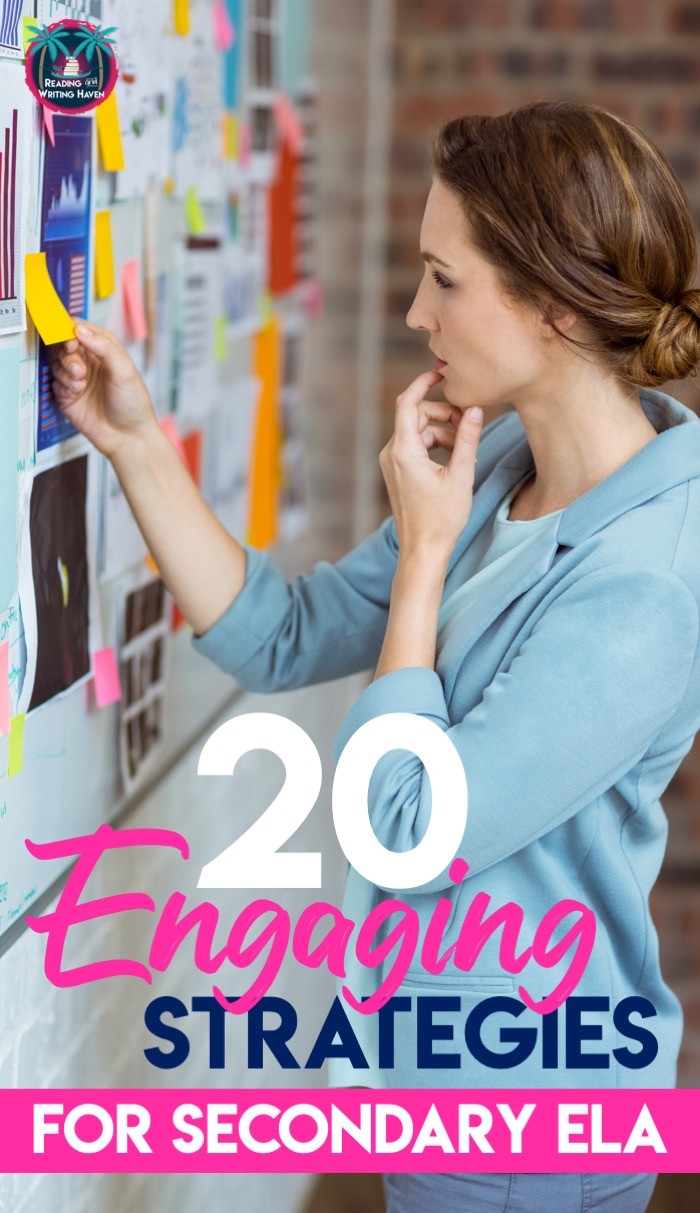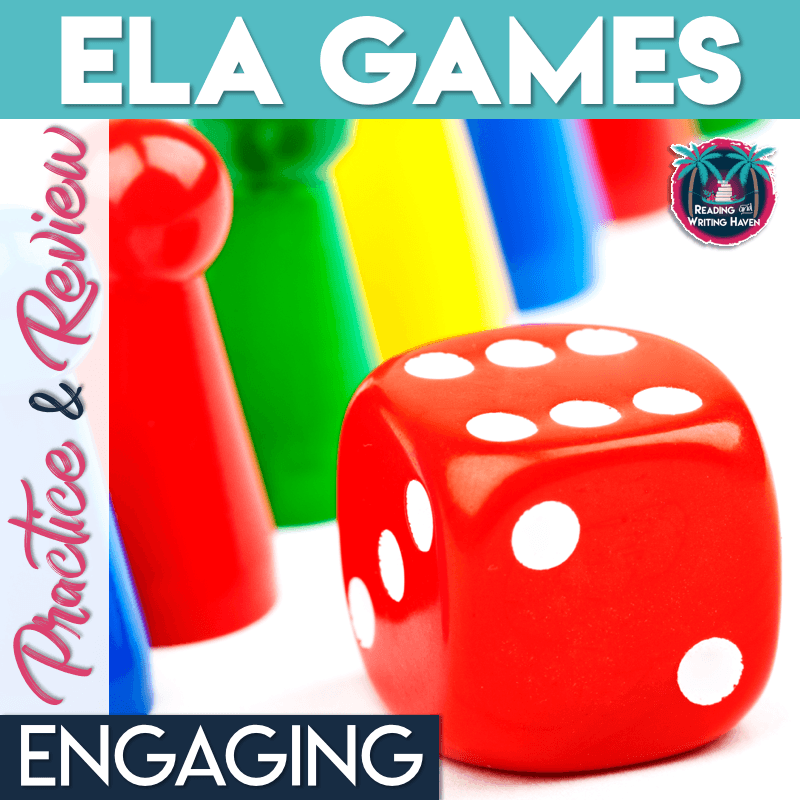How to Engage Students: 20 of the Best Active Learning Strategies
As a new teacher, I didn’t fully grasp how to best engage students in learning. That’s not to say my class was a bore, but there were definitely days I knew flopped…majorly. Unfortunately, there’s no magic list for captivating students in a lesson, but experience is one of the best tools I have to answer the question of how to engage students in the classroom. Developing a bank of lesson plans and approaches you can count on to increase engagement takes time.
There are few things I enjoy less than bored students. That’s why I’ve dedicated a lot of time and effort to trying new instructional strategies in the middle and high school classroom. If you’ve been scouring the web for ways to get and keep students engaged, hopefully you’ll enjoy this these active learning strategies.
Before diving into the strategies, I want to emphasize several important points.
First…
It’s hard to tell when students are truly engaged. I find that when I ask them for feedback on a lesson, they usually evaluate their interest level higher than I would have guessed. So, if students aren’t on the edge of their seats enthralled in the learning, it may just be because they are teenagers dealing with a crazy array of emotions and insecurities. Plus, engagement is not always visible externally.
Also…
Engagement is not a quick fix. It starts with building relationships with students and getting to know them as learners. Students will be more engaged in a room where they know the teacher cares about them. We have to constantly check the thermostat in the room to see what is working.
But…
Engagement shouldn’t come at the expense of learning. Some activities are engaging and fun, but the thinking required is very basic, or the tasks may not align to standards.
And…
Engagement is not the same as “fun” or even “entertaining.” Engagement means students see the value of the learning and are mentally engaging with the information, actively thinking, forming meaningful associations. Their thinking is challenged.
The list of instructional strategies we could try could really fill up a book (or more). Over time, I’ve collected a list of reliable and engaging strategies to use with middle and high school students. Let’s take a look.
1. MODEL ENGAGEMENT
It didn’t take me too long into my first year of teaching before I realized the importance of modeling engagement. Teaching the same lesson several times a day isn’t one of the perks of being a teacher, but the less enthusiastic I am about a lesson, the less engaged students tend to be. And, the reverse is true as well.
Wanting to engage students in independent reading? Show them how you are enjoying a book. Share your thoughts. Read some of it to them. Read when they can see you doing it.
Trying to engage reluctant writers? Model your struggles. Show them how to write a bad hook just to get something down on paper and then revise it. Smile the whole time! Ask thoughtful questions. For instance, I’m not loving this rough draft of a hook, but I’m so glad I at least have something on paper. I’d love your help! Who would like to help me make this better? What do you all suggest?
2. USE MUSIC
When we play music in the classroom, the energy changes. Whether we are using songs for intentional brain breaks (which are an engagement strategy as well!), as a mentor text for figurative language or grammar, or as a bell ringer, music brings life to the classroom. Here’s a free analytical music activity you can use with poetry.
3. USE ART
Use art in ELA to pique students’ interest. For example, I love encouraging students to think critically by drawing vocabulary associations or creating one pagers or sketch notes. They can analyze and evaluate graphic design elements by looking at author’s craft in picture books or by creating booksnaps to capture reflections. Use photographs as inspiration for writing or project images related to a text before reading. Then, have students make predictions or build background knowledge.
4. GIVE OWNERSHIP
If we really want to engage students in learning, we need to give them ownership: voice and choice. Involve them in making decisions about what happens in the classroom and about their learning. Ask for their feedback about lessons and units. Have them evaluate their work and progress. And, let students choose what they want to read as often as possible. Create and display anchor charts that showcase their ideas. With writing, give feedback that honors students’ internal dialogue.
5. MAKE IT RELEVANT
Students are more engaged in learning when lessons are relevant to real-world application. Tie literature to essential questions that help students understand life. Choose books in which they can see themselves or their culture present. Try passion projects or genius hours. Teach real-world writing skills like email etiquette and journaling. And, of course, bring in elements of pop culture whenever appropriate. I love using short films, music, commercials, and more to teach literary analysis.
6. INCORPORATE MOVEMENT
Any time we can incorporate movement in our classrooms, engagement tends to increase. Whether we are having students participate in a gallery walk, using manipulatives to understand language, or sorting information to categorize it, when students are standing and moving around, they are more likely to be engaged. Learning stations are one of my favorite ways to incorporate movement because students get to practice many skills related to the learning objectives…all from different learning perspectives.
7. PLAY GAMES
Games are crowd pleasers. This year, I asked my students…If you could take the skills I am asking you to learn and transform this lesson to make it exactly how you want to learn, what approach would you take? The answer? Resoundingly, games. They want to play games. Games are not ideal for every circumstance, but if students can play a game to practice a skill or strategy, they tend to be smiling, laughing, and collaborating more than with other approaches.
8. READ ALOUD
Students are never too old to be read to. I just attended a conference in which the presenter used several picture books as interactive read alouds with an adult audience, and everyone was enthralled. Picture books truly have to age cap. Whether you’re reading the first chapter of a book, the entire thing, a short story, or a picture books, you’ll notice students are more engaged.
9. CREATE VISUALS
Visual elements captivate students. Graphic organizers provide them with naturally differentiated entry points for discussion. Plus, the design of many graphic organizers elevates thinking more than a traditional worksheet. Anchor charts are effective because students can help create them, and they anchor learning so that students can refer back to them long after the lesson is over. EL and all students benefit from word walls, especially when they are interactive.
10. STOP AND JOT
Sometimes we are so busy disseminating information that we don’t stop often enough to let students think. And, thinking is critical for engagement! Try incorporating brain dumps, or stop and jots, as a way for students to write down what they remember as you move from one topic to another or between parts of the lesson. This type of activity is also helpful with removing “dead time” in the classroom, which diminishes engagement.
11. DISCUSSION WARM-UPS
Ever wonder how to engage students in class discussions? Try think, pair, square, which is a variation of think-pair-share. In think, pair, square, the teacher poses a question. (Students can pose questions also, determining on the purpose and goal).
Then, students do a brain dump on paper, writing down everything they think in response to that question. Following a short period of reflection, they turn to a partner and share those ideas. After, the partners pair up with another set of partners so that the discussion groups are somewhat larger.
You’ll notice that as students move from sharing with just one other person to four, the energy level in the room rises. Students also typically are more likely to participate in the whole-class discussion that follows.
12. CHUNK LESSONS
Lessons are more engaging when intentional chunking is built in. We can do this by breaking down course content and skills into smaller chunks that are more easy for students to digest as well as chunking the class period strategically to increase mastery of content.
When done effectively, students comprehend the content better, learn more of it, and remember it longer. Content chunking gives students time to really dig into a skill, idea, or concept long enough that they can appreciate it, reflect on it, and connect with it at a deeper level. Here are some specific chunking ideas for reading, writing, and other ELA topics.
13. REVAMP NOTE-TAKING
There are so many different ways students can take notes, but when we introduce new note-taking strategies that make students think and that they can use as a study strategy, engagement increases. One approach I have used this year is sketch noting. You can find a free lesson for introducing this strategy to students in my resource library (exclusive for subscribers).
Another is retrieve taking. With this strategy, students actually don’t take notes. They listen. Then, when you are done talking or the video is done playing, you pause and ask students to brain dump. Have them write down everything they remember. Obviously, you can insert these intentionally retrieval opportunities regularly during direct instruction to chunk the note taking.
14. PROVOKE CURIOSITY
When talking about how to engage students in learning, curiosity has to be part of the conversation. If students aren’t interested in what they are learning, it’s hard to engage them. Before reading, try projecting images and/or words that relate to the text. Have them begin making some predictions about the text. The images can serve to build background knowledge and prepare students to read as well.
Writing? Hold a debate before writing an argumentative essay. Analyze aspects of pop culture before writing a literary analysis piece. For informative writing, pique students’ interest by having them select a topic based off of questions they have about a fiction text (ex. – Why did Henry VIII have six wives? or What technology has already been invented that is similar to what is described in the book?).
This whole post is full of a variety of anticipatory sets, or lesson hooks, that can help to engage students in learning.
15. ACTIVATE THE BRAIN
In order to engage students in learning, they need to experience the excitement of retaining new information. When learning is tangible, or measurable, students tend to be more motivated. Part of my teaching philosophy involves incorporating brain-based learning approaches whenever possible. We know students learn better when they are making meaningful associations, collaborating with others, and doing the work.
While I incorporate elements of brain-based learning in all aspects of ELA, one of the areas I have the most fun with it is in vocabulary. Here are five brain-based vocabulary activities, and you’ll find even more in this resource, which you can use with any word list.
16. USE COLOR
Color brightens moods, lessons, and learning. There’s something about color that intrigues us and helps us to remember what we learn. Students can color-code elements of a paragaraph when writing. Color can also help students understand book diet and book fit. Try color coding mood and tone or grammatical elements so that students can visually see how the elements work together. This list provides details for these ideas and more.
17. ADD TECH
Take any lesson and “engage-ify”it by adding meaningful tech. For example, to have students show their thinking about characters, plot, and conflict, ask them to use the free app called Texting Story to create a short video conversation. To reflect on the writing process and what students learn as they move through each phase, have them document their experience each day using Apple Clips. Students can conduct research and visually display what they learn by creating an infographic on Canva. Try using Notability to create a mindmap or other visual notes to synthesize learning. Or, ask students to insert a GIF into a shared Google Slide document to represent their current feeling about the topic of discussion.
18. MAKE IT COLLABORATIVE
When we picture the gradual release of learning, we sometimes skip over collaboration. It takes time! But, the social nature of learning is so important for students. To maximize engagement, whenever possible, ask students to work together to share ideas about what they are reading, to revise their writing, to respond to one another in verbal and silent discussions, and to partake in research projects.
19. TRY A PODCAST
Podcasts require a different type of listening. Students can build their listening comprehension while learning auditorily from an informational text. Podcasts are especially engaging when the topic is intriguing or relevant to students. Here is a list of podcasts for students from Common Sense media, and this is a high-interest podcast lesson I recommend for high school students.
20. CHALLENGE STUDENTS
No one likes to be bored. Students appreciate the type of challenge that makes them think but doesn’t frustrate them. Ask questions that challenge students’ thinking in developmentally appropriate ways. Encourage them to participate in some metacognition, but always avoid busy work.
True student engagement is not the same as participation. With participation, students may be doing what we ask them to. They may be raising their hands at the appropriate times, but that doesn’t mean they are mentally an emotionally engaging or connecting with the lesson.
So, in order to answer the question of how to engage students in the learning process, we need to look beyond all the strategies and start thinking about how we can intentionally build active learning into our classrooms. Engagement increases students’ attention, sharpens their focus, motivates them to think at a higher level, and promotes meaningful learning.
Meaningful learning boils down to knowing our students well enough to create lessons they find relevant.
It’s really more about purposeful lesson design than it is randomly selecting a strategy from a list. Ultimately, I notice maximum engagement when I have just enough structure in my room for it to feel safe, but also just enough variety in active learning activities to keep students on their toes.
READ NEXT:
Meaningful End-of-the-Year Activities for Secondary ELA
Engaging ELA Activities for Any Time of Year
11 Ideas for Teaching Figurative Language Meaningfully
RELATED RESOURCE:
Engage students in meaningful review and practice with these ELA games. Perfect for learning stations and review sessions.



